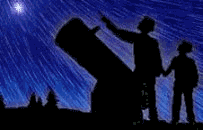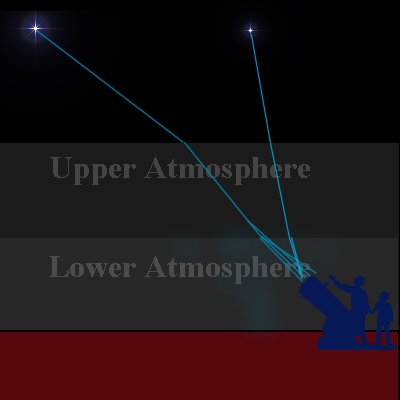

 |
 |
| Star Light Star Bright Why Do You Twinkle Tonight? |

Have you ever looked up on a cool crisp night and seen the stars up there burning bright and dancing around? On other nights have you ever noticed the stars just sitting up there shining steady? These are two different examples of what is called seeing. On the night where the stars seem bright but are twinkling wildly, though pretty, this is an example of poor seeing. Then there are the nights where the stars just sit there, steadily burning holes into the black sky; this is an example of good seeing. Both of the nights are dark, and the night sky looks like black velvet. What could cause the poor seeing? Unstable air is what causes the stars to twinkle and more the stars twinkle the more unstable the air is. One of the ways to tell a planet from a star is to see if it twinkles or not. Generally a planet will not twinkle and a star will. This is due to the apparent size of each. A star is a point of light and if you look at it through a telescope it will be just a brighter point of light. This is due to the tremendous distances stars are at. Planets on the other hand are extremely close by astronomicaly speaking. With just your eyes a planet may look like a point of light but in a telescope it can be seen as a disk. It is this difference that allows stars to twinkle while the planet shines steady. The paths of light that define the point of light that makes a stars image is so fine that almost any little air disturbance will interfere. While a planets disk takes a larger air disturbance to interfere with its image as a disk. But we don't look at planets to just see its disk. We also want to see as much detail on that disk as possible. This is where the air disturbances will interfere and you will want to wait for good seeing nights for viewing detail. If you are viewing lets say Jupiter and you can see the cloud bands but no detail, don't give up. Be patient and wait; often there will be short moments of crystal clear seeing where detail will suddenly stand out.
The more air the light has to go through the more turblence it is likely to go through. Hot objects such as parking lots, dirt fields, and houses heat up air and cause it to rise. This is turblance. Avoid view ing over such objects and/or wait untill they have cooled down. Generaly the air steadys as the night goes on as the ground cools and causes less turblence, but it can be caused by high wind, inversion layer, etc.
Here are some tips: